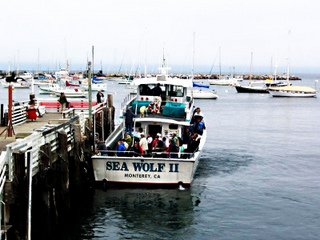Discover Northern California's
Tips for Whale Watching Asea
Whale Watching Tips When You're Asea
Mixing boats and whales can bring you into pretty close proximity, especially if you're on a small personal craft. As exciting as that might seem, please try to remember that whales are wild animals like elephant and giraffe... We can't predict where they might go or what they might do.
But before we get to our tips specific to when you're doing your whale watching from a boat, a quick review of our general tips for whale watching:
For the best possible whale watching experience:
- Plan your trip for peak whale watching season
- Pick a spot that's known for its whale watching
- Choose a calm, clear day
- Be patient
- And things to bring along:
A good pair of binoculars;
A camera or video cam with a decent zoom lens;
Sun screen and sun glasses;
Warm clothes, in case it turns nippy;
A picnic lunch, snacks, and something to drink
Commercial whale watching boats are
generally skippered by experienced seamen and often carry a wildlife
expert who will share information with you about what to look for and
what exactly you're seeing when you find something.
Do you have a favorite
NorCal story?
From a family visit from years ago to something
you discovered last weekend,
Share it with
the rest of us - we'd love to learn about it!
To find the best hotel prices for your Northern California whale watching trips, compare at HotelsCombined.com:

Whale Watching Tips for When You're Whale Watching from a Boat
|
|
When you go out on a boat - whale watching asea - whether it's your own or a hired whale watching cruise, there are some extra considerations:
|
There are many options these days, from the familiar Dramamine
to Sea Bands to The Patch and more...
- Bring or wear rubber-soled shoes for your own safety
Boat decks can be wet and slippery. It'll really spoil your trip if you fall and break something, or - worse yet- end up overboard! - Consider a hat and/or ear protection
It can be very windy when you're asea. You'll be more comfortable if you don't get an earache, and views will be better without your hair whipping in your face - Head for the upper deck and the starboard (or right-hand) side
The best place on the boat for viewing the whales is on the upper deck. You'll be above the level of the sea, and it's usually less crowded.
How to whale watch, and what to look for: when you're whale watching, this is how to go about it and what you'll be looking for...
- Scan the surface of the water rather than looking down into it
- Look for a blow, or spout (as seen above) - when the whale surfaces after a dive, he'll blow the air out through his blow hole, creating a misty vapor jet
- Also look for whale footprints, especially if you're on a high promontory - you may be able to spot the glassy mark a whale makes on the surface of the ocean, almost like an oil slick (see photo at Tips for Whale Watching)
In addition to the many species of whale you may spot from asea, you may also encounter dolphins and porpoise, sea otters, sea turtles, and plenty of ocean-going waterfowl.
For more whale watching tips and information, click on any of the links below:
- Tips for When You're Ashore
Tips to get the most from whale watching from land - Planning Your Whale Watching Trip Ashore
What you need to know for whale watching from Northern California shores - Planning Your Whale Watching Trip Asea
What you need to know for arranging your whale watching from a boat - Tips for When You're Aloft
Tips to help you get the most from whale watching from a plane - Planning Your Whale Watching Trip Aloft
How to plan a whale watching trip from the air - Whale Watching Videos
See what you've been missing!
Please continue your exploration of what Northern California has to offer by using the Nav Bars in the left and right columns or by using the links at the bottom of the page.
Return to Discover Northern California's Home Page
from Whale Watching Tips When You're Asea
Related Articles
Whale Watching
Whale Watching Tips
Planning Your Trip Ashore
WW Tips Ashore
Planning Your Trip Asea
WW Tips Asea
Planning Your Trip Aloft
WW Tips Aloft
Related Pages
Hints & Tips
Beach Safety Tips
Best Kept Travel Secrets
Family Camping Tips
iPhone Travel Apps
Nude Beaches
Tide Pool Tips
Travel Sites We Love
Travel Tips
Whale Watching Tips
Wine Tasting Tips
Winter Driving Tips
Related Pages
Things To Do
Activity Village
Attractions
Beaches
Beer Lovers Delight
Burney Falls
Camping
Casa de Fruta
Day Trips
Gold Panning
Gold Rush Sites
Healdsburg
Historic Grass Valley
Lake Shasta Caverns
Lodi
Missions
Nevada City
RV Destinations
Ski Resorts
Tide Pool Tips
Travel Tips
Weekend Trips
Whale Watching
Wine Tasting
Related Pages
Free Things To Do
Free in Big Sur
Free in Chico
Free in San Francisco
Free in Sonoma
Related Pages
Insider Secrets
Best Kept Travel Secrets
Best Winter Whitewater
Boring Road? Nope
CA Admission Day
Climbing at Castle Rock
Crabbing Spots
Dream of Dreams
Fall in Eastern Sierras
Ghost Stories
Glass Beach
Great Stays, Low Pays
How to be a Valley Girl
Jade Beach
Lake Shasta Caverns
Lassen Volcanic SP
Lost Coast
Mono Lake
Moss Landing: Whales
New Clairvaux Abbey
Panning for Gold
Pygmy Forest
Mendo to Eureka
RV Destinations
SF Great Places to Eat
SF: More About Eating
SF Neighborhoods
SF Giants Baseball
Santa Cruz: Memories
Santa Cruz: Old Friends
Sonoma Cooking Class
Sonoma History
Sonoma Top Wine Stop
Tahoe: Discovery Trail
Underground Gardens
Yosemite: Family Hikes
Yosemite: High Country
YNP: Off the Beaten Path
Yosemite: Taft Point
Ziplines
